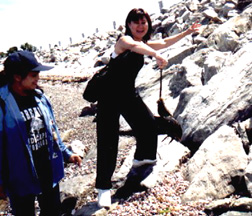
Activities preceding a field trip to the rocky shore and barrier beach:
We divided the class into small
groups and handed out index cards with vocabulary relating to the rocky
shore written on the top. At the local library students answered
the following questions for each vocabulary word.
1. What does it look like?
2. Where is it found?
3. What does it eat?
Anyone who has the vocabulary word lighthouse needs to answer the following questions.
1. Where are lighthouses found?
2. What is the function of a lighthouse?
3. Find where Beavertail Lighthouse is located on Jamestown, RI.
Put your answers on the file
cards.
After doing this research in the library students returned to class and shared their findings with each other. This was a very successful activity.
We also used the printout found
on the University
of Rhode Island (Life Zones of the Rocky Shore) website to discuss
and identify the flora and fauna found on the rocky shore. This was
a very good precursor to our field trip to the Jamestown and Colt State
Park rocky shores. After this discussion we then constructed a replica
of the rocky shore life zones on the classroom wall. Students worked
in groups. Each group was responsible for either drawing or finding
pictures of the flora and fauna for their particular tidal zone.
This activity afforded an opportunity for students to discuss and analyze
the material.
The main activity of the field
trips to the rocky shore was the following handout. We divided the
students into groups and supplied them with buckets and plastic bags.

1. limpet
2. rockweed
3. clam
4. crab (green, hermit or fiddler)
5. barnacle
6. oyster
7. quahog
8. mussel
9. bivalve (two-shelled)
10. eel grass
11. kelp
12. byssal thread
13. dog whelk
14. pyrite (fool's gold)
15. silver fish
16. sea star
17. mermaid's purse (egg case)
18. periwinkle
As you walk along the areas we visit, observe the different eco-system types and answer the following questions.
1. Make a list of man-made pollutants you can see are harmful to fragile eco-systems.
2. List ways in which the rocky shore is different from the barrier beach. List ways in which the rocky shore is different from the salt marsh.